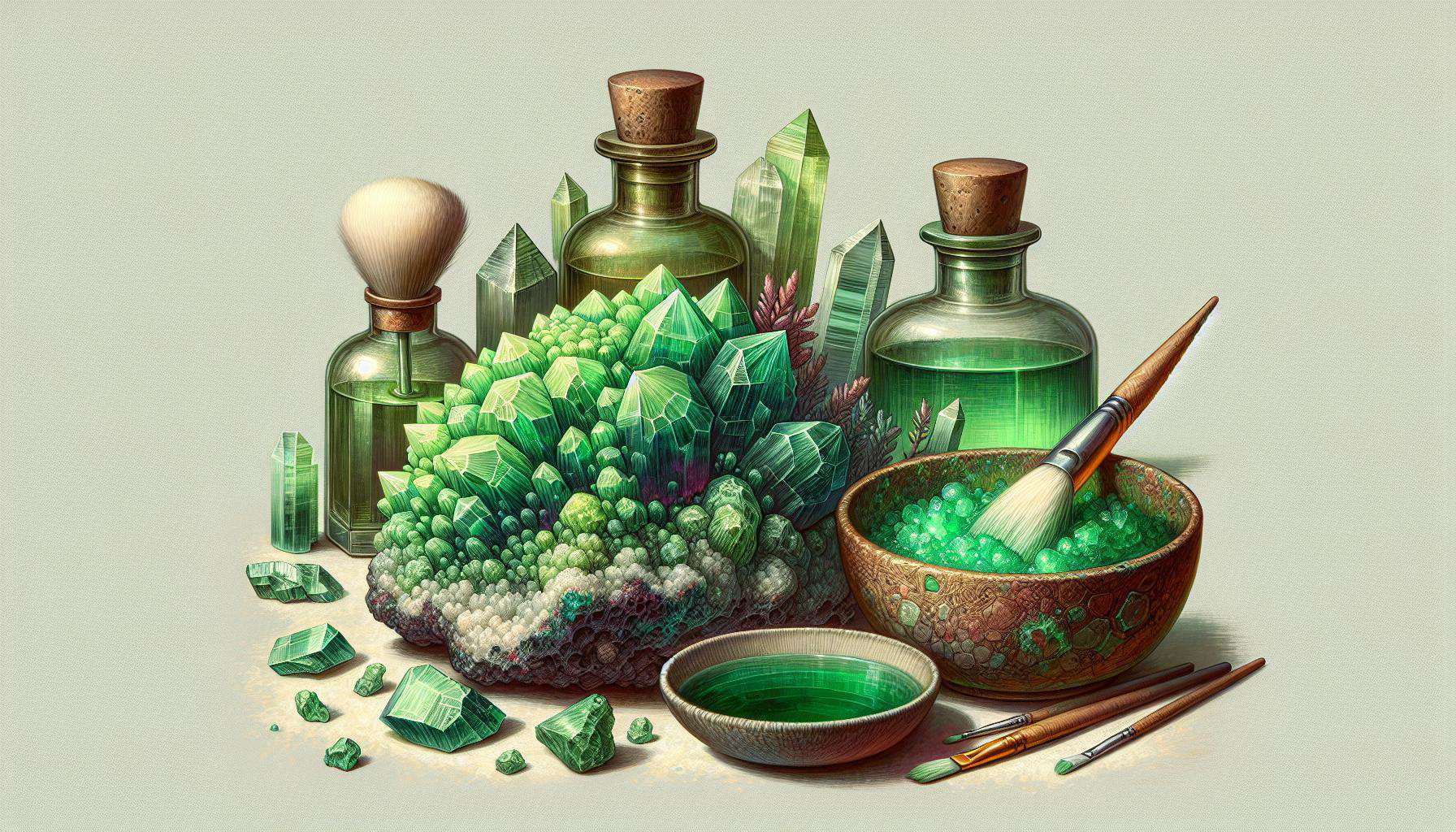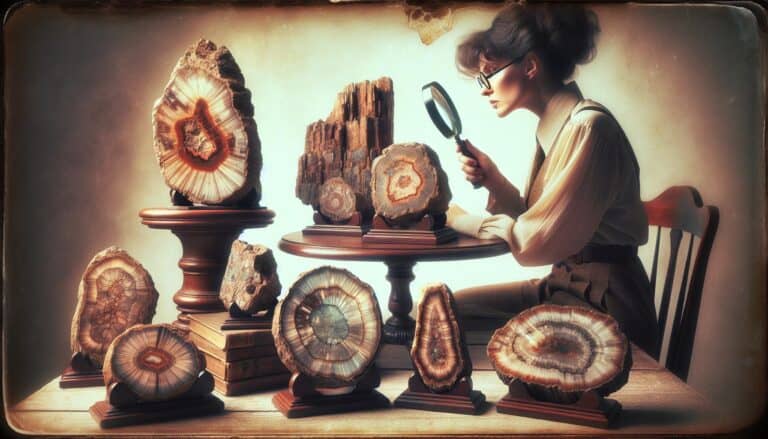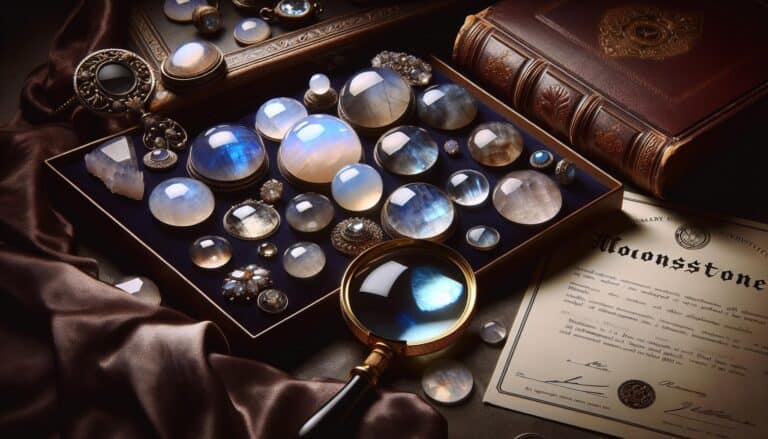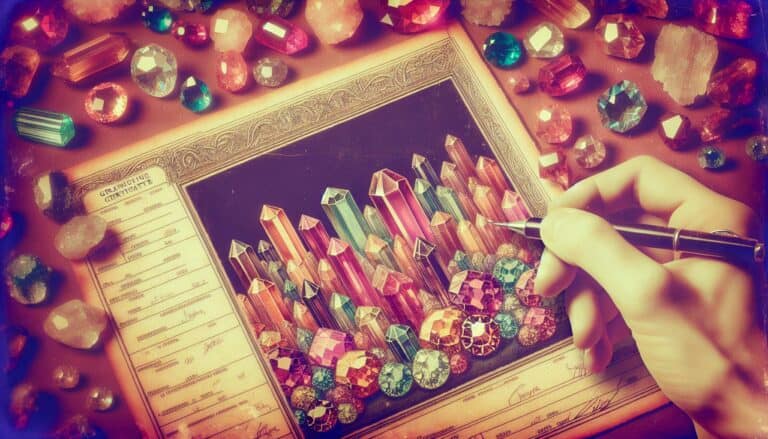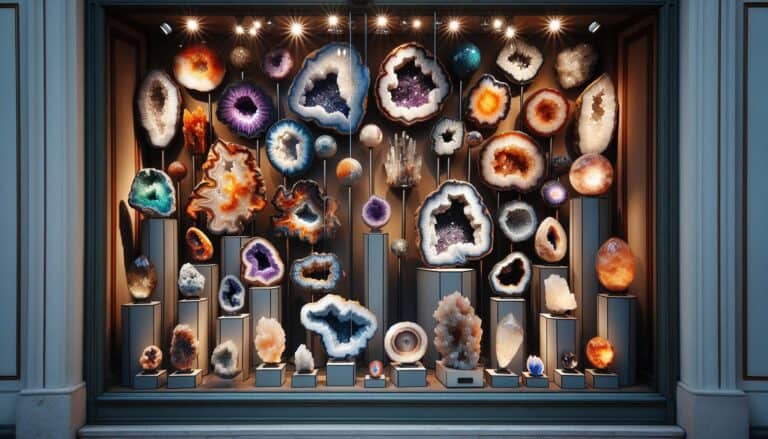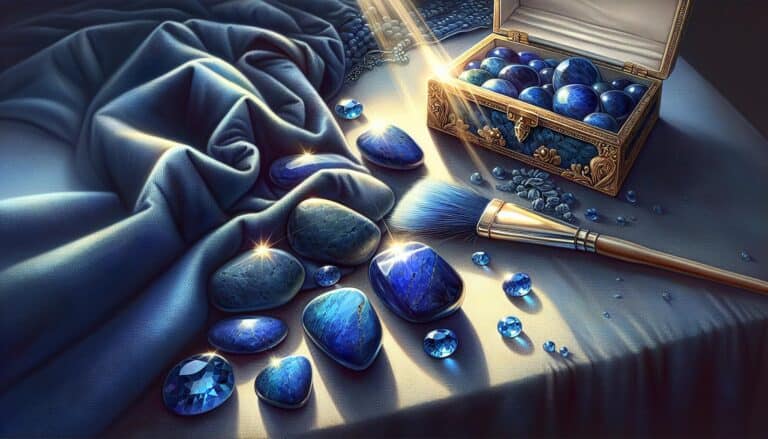Discovering the secrets of minerals can be thrilling, and identifying epidote is no exception.
You’ve likely stumbled upon this unique mineral while exploring nature or sifting through a rock collection. It’s known for its distinctive green color and is a common find for gem enthusiasts.
But how do you distinguish epidote from other minerals? It’s all about knowing what to look for. With its pistachio hues and elongated crystals, epidote has specific characteristics that set it apart.
Get ready to become an identification pro as we delve into the world of this fascinating mineral.
Spot real epidote by its pistachio green, elongated crystals, glassy shine, and hardness of 6-7. Use streak, magnet, and hardness tests. Look for double refraction and metamorphic origins. Prepare tools and prioritize safety. Gently clean and store finds wisely. Unique green and crystals are key!
How to Identify Epidote Through Testing
When you’re out hunting for minerals, identifying epidote can be both exciting and challenging. Beyond its distinctive green color, there are tests you can perform to confirm your finds. Be sure to conduct these tests carefully to avoid damaging your specimens.
Visual Inspection
First up, perform a thorough visual inspection. Check for epidote’s typical green color which can range from pistachio to nearly black. Keep an eye out for its classic elongated crystal form and look for a glassy or vitreous luster, which can be a giveaway for epidote.
The Streak Test
The streak test is fundamental in mineral identification. Drag your specimen across an unglazed porcelain tile and observe the color of the streak it leaves behind. Epidote usually leaves a grey or white streak, distinguishing it from similar green minerals that might leave a colored streak.
Magnet Test
Epidote is not magnetic, so if your mineral is attracted to a magnet, it’s likely not epidote.
Hardness Test
Use the Mohs hardness scale to determine if your mineral is epidote. Epidote has a hardness of 6 to 7, meaning it will scratch glass and steel but can be scratched by harder substances like a diamond.
Birefringence Test
Birefringence is the optical property of a material having a different refractive index along different axes. In layman’s terms, when you look through a thin piece of epidote under polarized light, you’ll see two images. This double image effect is a good indicator of epidote.
Checking The Diaphaneity
Diaphaneity refers to the transparency or translucency of a mineral. Epidote may exhibit different levels of diaphaneity, from transparent to nearly opaque. Knowing this can be helpful in identification.
Single or Double Refraction
Epidote, being anisotropic, shows double refraction. When viewing through a clear piece, images appear doubled and slightly off-set — this confirms the double refraction characteristic of epidote.
Refractive Index Test
Professional gemologists can measure the refractive index of your specimen to help confirm if it’s epidote. This test involves sophisticated equipment and might not be practical for amateur collectors. For epidote, the refractive index ranges from 1.715 to 1.751.
Finding The Specific Gravity
The specific gravity of a mineral is a measure of its density. Epidote has a specific gravity between 3.25 and 3.50, which is higher than average for silicate minerals. You’ll need a balance scale to perform this test accurately.
| Material | Specific Gravity Range |
|---|---|
| Epidote | 3.25 – 3.50 |
Identifying Epidotes in the Field
While in the field, use a strong light and a hand lens to inspect suspected epidote rocks. Good specimens may show the crystal shapes and cleavage planes indicative of epidote.
Recognizing Potential Epidote Rocks
If you’ve found a rock you think might contain epidote, check for associated minerals. Quartz and calcite are often found in the same environments as epidote. Remember, it’s the combination of these tests and observations that will increase your confidence in accurately identifying epidote out in the wild.
Physical Characteristics of Epidote

Epidote is a distinctive mineral that’s fairly easy to identify when you know what to look for. The mineral typically presents itself in various shades of green, from yellowish-green to pistachio. Color variations can be a key indicator, but remember, color alone won’t confirm an epidote identification.
Crystal habit—or the shape and form that crystals take—is another characteristic feature of epidote. You’re likely to spot elongated and striated crystals. These crystals, often prismatic, are a good sign you’re dealing with epidote.
Its luster tends to be vitreous, meaning it has a glassy appearance that can help differentiate it from other minerals. Observing a mineral’s luster can be as simple as examining how it reflects light, a step that doesn’t require any specialized tools.
In terms of cleavage, epidote has one direction of perfect cleavage and a distinct uneven fracture. When inspecting a sample, look for smooth flat surfaces that reflect light differently from the naturally broken parts.
| Property | Description |
|---|---|
| Color | Yellowish-green to pistachio |
| Crystal Habit | Elongated, prismatic, striated |
| Luster | Vitreous |
| Cleavage | One direction of perfect |
| Fracture | Uneven |
Take note of the hardness as well. Epidote ranks about 6 to 7 on the Mohs scale, making it relatively hard; it won’t scratch easily with a steel blade. This is a crucial test to confirm the mineral’s identity, as it can help rule out softer look-alikes.
Remember, epidote’s diaphaneity ranges from transparent to nearly opaque. This measure of transparency can vary within a single specimen, giving you clues about its purity and composition. Keep an eye out for transparency variations as they reveal much about the specific characteristics of the sample in your hands.
Exploring these physical characteristics reinforces the information on tests like hardness and birefringence discussed earlier, creating a comprehensive picture of how to approach your epidote identification in the field.
How Are Epidote Formed?
Epidote is a complex mineral that forms under a specific set of geological conditions. Primarily, it’s the result of low-to-medium-grade metamorphism, which is a process where existing rocks are transformed by heat, pressure, and chemically active fluids. Generally, these conditions are associated with the subduction of tectonic plates where rocks are subjected to dramatic environmental changes.
Your journey to understand epidote formation should also consider its common associations with minerals like quartz, calcite, and chlorite. Epidote typically occurs alongside these minerals in metabasites, rocks which have undergone extensive metamorphism from their original basaltic composition.
The mineral can also form through hydrothermal processes, where superheated water rich in minerals infiltrates rock formations, altering their chemical structure to create new mineral deposits. Epidote crystals precipitate out of these fluids, filling cracks and voids in the host rock.
Epidote’s distinctive pistachio green color and unique crystal structure are clues to its metamorphic origins. As you explore regions known for metamorphic rocks, keep an eye out for this telltale green mineral — it might just be epidote. Remember, these formation processes are intricately linked to the identification characteristics previously discussed.
Preparation for Epidote Hunting
Before heading out to hunt for epidote, ensure you are well-prepared with the right equipment and knowledge about safety measures. Proper preparation not only makes your search more effective but also keeps you safe as you explore different terrains.
Gathering the Right Tools
To have a successful epidote hunting trip, you’ll need to assemble the proper tools. Below is a list of essential equipment to carry along:
- Geologist’s hammer: For chipping away at rocks and extracting potential samples.
- Hand lens: To closely inspect the crystals and determine physical characteristics.
- GPS device or map and compass: For navigation purposes, especially in remote areas.
- Field notebook and pen: To record the location and other details of your finds.
- Sturdy bags or containers: To safely transport your specimens.
Remember to also carry adequate water, snacks, and a first-aid kit to address basic needs and potential minor injuries. The right tools not only make your trip productive but also enable you to handle unexpected situations.
Safety Considerations
The pursuit of epidote necessitates adherence to safety protocols to avoid accidents and injuries. Here are key safety considerations to keep in mind:
- Wear appropriate attire: Protective clothing — including long pants, a sturdy shirt, steel-toed boots, and gloves — is essential for protection against sharp rocks and vegetation.
- Protect your eyes: Safety glasses can safeguard your eyes from flying debris when chipping at rocks.
- Stay aware of your surroundings: Be cautious of wildlife, unstable terrain, and potential weather changes.
- Inform someone of your plan: Always let a friend or family member know where you’ll be and when you expect to return.
By prioritizing safety, you not only look after your well-being but also ensure that you can fully focus on the thrill of finding epidote without unnecessary interruptions.
Handling and Care of Found Epidote

After you’ve successfully identified and collected epidote specimens, it’s important to know how to handle and care for them properly. Preserving the natural beauty and integrity of your find means following certain practices to clean and store your epidote minerals effectively.
Cleaning and Storing Epidotes
Initial cleaning of epidote is crucial for maintaining its quality. Begin by gently removing dirt using a soft brush. Be mindful that the mineral’s surface is not scratched during the process. If your specimen has tougher sediments, lukewarm water can help loosen them. Avoid household cleaners; they can react with the minerals and alter their appearance.
Once the visible dirt is off, you may choose to soak the epidote in distilled water for several hours. This helps to dissolve any remaining particles, which can then be brushed away easily. After cleaning, pat the specimen dry with a soft towel to prevent water spots.
Proper storage is equally vital to safeguard your epidote’s condition. Here are a few points to keep in mind:
- Wrap each piece individually in a soft cloth or place it inside a padded box to prevent scratches.
- Store in a cool, dry place to prevent any damage from humidity.
- Keep epidote away from direct sunlight as prolonged exposure can fade its distinctive color.
For collectors who prioritize long-term preservation, consider labeling specimens with pertinent information like the date of discovery and the location where it was found. This practice not only helps in maintaining a well-organized collection but also adds value to your specimens.
With these simple steps, you’ll ensure your epidote remains in pristine condition, preserving its natural luster and historical significance for years to come. Remember as you continue your quest for minerals, always prioritize the quality and care of each unique find.
Conclusion: Confirming Epidote are Real
Recognizing epidote’s unique characteristics will help you confirm your find with confidence.
Remember, it’s the pistachio green hue and distinct crystal structure that often give it away. Once you’ve identified your specimen, proper care is crucial. Gently clean with a soft brush and lukewarm water to maintain its natural luster. Store your epidote correctly by wrapping it in a soft cloth and placing it in a cool, dry area away from sunlight. Don’t forget to label your specimen—it’s not just about organization, it’s about enhancing the value of your collection.
With these tips, you’re well on your way to becoming a savvy epidote collector.

